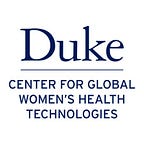Recap of “Equalize Health: Medical Technology for Everyone,” With Dr. Krista Donaldson
Last week, as a part of our Leaders in Global Health Seminar Series, we spoke with Dr. Krista Donaldson, the CEO of a global, not-for-profit medical technology company called Equalize Health, as she spoke with us about implementing user-specific health care designs in the field of global health.
In this event recap, we touch on a few key topics of discussion from the event. We also encourage you to watch the full discussion on our YouTube channel.
Dr. Donaldson began her talk by telling us a little bit about herself and her studies in mechanical engineering and aquatic design as a student, and how they were utilized in her first job at KickStart, a company that develops water pumps for farmers in various countries, where she worked with the manufacturing division. She then spoke about the tragedy that struck while she was there and the impact it had on her then, and in future endeavors around the world.
Dr. Donaldson then moved on to tell us about the early days of Equalize Health, which was called Design Revolution (D-Rev) when she was first introduced to it. The focus of the 12 year old business started with general design in terms of global good, but then expanded to health, specifically newborn health, and later, include maternal health. She spoke about the early days of the company and its successes, and some of the early projects that the company worked on.
“We like to say we’re a non-profit that acts like a for-profit — except our currency is impact” — Krista Donaldson, Equalize Health
The beginnings of Equalize Health sprouted from issues in technology distribution in low and middle income countries, and how they are given devices not properly suited for the resources available in each respective country since most companies put an emphasis on affordability over usability. The principles of Equalize Health center around trying to understand the needs of the people who will be using the device, the markets in which they are sold in, and the standard of care of their products.
She then told a story about a nurse who works at a clinic in Uganda, and the experience she had with a patient’s birth complication, which was only exacerbated by a lack of proper resources and health infrastructure. She shared how this experience had a hand in changing the work model of Equalize Health to include factors such as user and market intelligence, partners and acquisitions, and local ecosystem support. The current goal of the company is to treat 5 million people by 2025.
After Dr. Donaldson’s presentation, we moved into a live Q&A session, which touched on the work of Equalize Health, how they plan to move forward to include countries all over the world, possible expansion to non-healthcare focused fields such as clean energy, and several other interesting topics.
